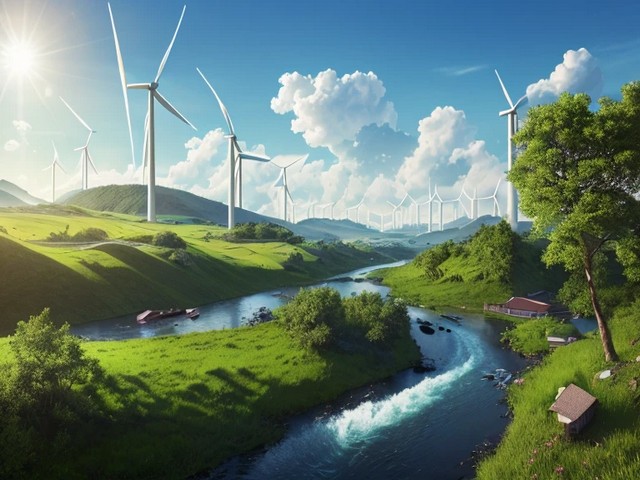
AI climate change is already a promising topic and is popular among scientists and government officials. When considering the threats of global warming and their edge pulls that are gradually being felt in societies, there is a budding awareness of climate change’s possibility through the use of Artificial Intelligence. There are novel uses of AI in fighting global warming where machine learning plays a central role.
It is important to understand the distinctions between global warming and climate change as we deal with these problems. But whereas global warming can be described as the increase in the Earth’s temperature, climate change is more general in its scope. In the fight against climate change, Artificial Intelligence can use billions of cases and assess the weather, energy consumption, and improved carbonization options. When it comes to AI Climate Change solutions it isn’t all just on paper, there are real implementations.
For example, using machine learning it is possible to analyze the rate at which forests are being cut down so that the right measures can be taken. In the same way, every sector that can be made renewable can be made efficient by the help of AI making them more viable revenue-generating alternatives to fossil fuels. Therefore, the activity and involvement of Artificial Intelligence in lessening the effects of climate change is diverse.
Applying AI in solving issues of climate change will help in creating better agriculture practices, and in creating better disaster response systems, as well as better ways of planning our cities. AI Climate Change initiatives are preparing the ground for what is widely expected to be even more sustainable in the near future.
Therefore, the application of Climate Change AI provides various opportunities to reduce the global warming effect. Our sophisticated approach to global warming vs climate change can mean only one thing; when using sophisticated machine learning to solve complex problems, the solution will be unique and unprecedented.

Understanding Global Warming vs Climate Change
Climate Change initiatives of Artificial Intelligence are now changing the perception and handling of Global Warming vs. Climate Change. They are now proving to be useful in finding patterns and even in finding solutions to global warming.
Defining Global Warming and Climate Change
Global warming can be described more specifically as the increase in average world temperature, chiefly brought about by the burning of fossil fuels. Climate change, on the other hand, is a much wider process that involves changes in the climate and the occurrence of climate variations such as changes in weather, sea level, and the regularity of occurrence of unfavorable climate conditions.
The Role of AI in Addressing Environmental Challenges
The application of artificial intelligence in climate change enhances the solutions through an integration of machine learning for large environmental data sets. It can be used to make predicated weather and climates to understand their effects and come up with an efficient solution to it.
AI Applications in Climate Monitoring
Some of the applications of AI technologies are in the climate monitoring systems which are being adopted in the modern world. For example, analyzing satellite imagery with AI can monitor changes in forest cover, ice coverage, and ocean temperatures. This data is extremely important in appreciating the level of global warming and how to tackle it.
Predictive Modeling and Risk Assessment
Some of the AI climate change solutions are; predictive modeling to forecast future climatic conditions. Such models assist governments and organizations in planning for calamities such as floods or hurricanes for instance through accurate evaluation of risks.
Energy Efficiency and Renewable Sources
AI is also important in energy efficiency and the proper incorporation of renewable energy into the system. The adoption of smart grid systems and the use of technology such as AI to enhance the management of energy can in a major way help in curbing greenhouse emissions which would be a great stride towards the fight against global warming.
Adaptation and Mitigation Strategies
AI helps in formulating ideas concerning adaptation and mitigation measures. With properly used climate data, AI can determine the proper approaches to agriculture, water, and urban management to achieve sustainability when the climate changes.

The Role of AI in Climate Change Mitigation
AI Climate Change has emerged as a key focal area, and it’s central to the campaign against global warming. Thus, with the help of AI, researchers and industries can develop new solutions to fight the complex battle that has arisen with the help of the global warming vs climate change issue. This is not only essential but also timely technology to promote environmentally friendly practices in the world.
Forecasting and Predictive Analytics
AI to solve climate change is greatly dependent on the ability of AI to predict environmental changes. Computational models use large data obtained from satellite images, meteorological charts, and climate records for prognosis. Such predictions allow the relevant policy decision-makers to predict and prevent problems before they worsen.
Energy Efficiency and Management
There are multiple approaches that AI takes to tackle global warming with the most effective being consumption optimization. Advanced smart grids with the usage of AI techniques can enhance energy supply and its usage in a better and efficient manner, by minimizing wastage and optimally using renewable resources. The trend highlighted here of AI-optimized energy solutions extends benefits not only for the environment but also in the context of cost savings for people and other industries as well.
Carbon Footprint Reduction
AI Climate Change initiatives are also directed towards the reduction of carbon impacts. AI technologies assist industries in detecting and controlling their emissions through enhanced machine learning models. In addition to using the resources, AI technologies can monitor the firms’ carbon footprint and advise them on how best to minimize it, thus acting as a direct solution to climate change.
Innovative Environmental Monitoring
Such an integration facilitates the application of advanced environmental monitoring systems. With the help of drones and sensors incorporated with AI, deforestation, glacier melting, and pollution in the oceans can be tracked in real time. This fast feedback loop is very essential for the fight against global warming vs climate change where action to curb the degradation of the environment must be taken as soon as possible.
Public Awareness and Education
AI Climate Change tools are also as important in creating awareness among the public. SMEs with the help of AI can incorporate educative interactive tools and platforms that will close the gap between global warming, and climate change, and most importantly help the masses to understand scientific findings and data. Such awareness is desirable for co-ordinate action to environmental problems.

Key Areas Where AI is Combating Global Warming
AI Climate Change is changing the ways of combating climate change by presenting new methods of combating the further increase in temperatures. Recent trends in artificial intelligence particularly in machine learning are helping researchers and policymakers to predict and counter the effects of climate change. Here are some key areas where AI is making a significant impact: Here are some key areas where AI is making a significant impact:
Predictive Analytics for Climate Modeling
Machine learning for Climate Change indicates that Predictive analytics for climate modeling is being boosted by AI. Accurate climate patterns by machine learning algorithms can predict more comprehensive data due to their ability to handle large data processors. This in turn assists scientists in the early predictions of cyclones, monsoons, droughts, global warming, and so on, and the related prediction of the harms on individual ecosystems.
Renewable Energy Optimization
Renewable energy systems require efficient AI to function at their full potential. Using AI techniques, data gathered from solar panels, wind turbines as well as other renewable source can be analyzed to improve efficiency and minimize energy wastage. This not only fights global warming but also acts as an encouragement to shift toward using clean energy instead of fossil energy.
Carbon Footprint Reduction
The use of artificial intelligence is being done to track and minimize the emission of carbon. Some of the ways where AI is helping to reduce greenhouse gas emissions include smart grids, energy-efficient buildings, and intelligent transportation systems. AI to solve climate change consists of processes of finding solutions on how different industries can minimize their emissions of carbon.
Biodiversity Conservation
It is also worth mentioning that AI is also crucial to the protection of the world’s many species and ecosystems or in other words, the conservation of the global species richness. Climate change zones can be detected using information from satellite imagery, drone sensors, and AI. It assists in putting measures that help in enhancing the protection of endangered species and their ecosystems hence, solving some of the global warming vs climate change.
Enhanced Agricultural Practices
Its application in agriculture has involved the use of artificial intelligence to increase the yields of crops while at the same time having a friendly impact on the environment. The utilization of AI in smart farming by predicting the state of the soil, weather conditions, and the required irrigation schedule meant for plants and crops not only helps in saving farming resources but also helps in curbing global warming to some extent.
Waste Management
AI is bringing major changes to the entire waste management process. With the help of refined algorithms and knowledge in the methods of sorting and prediction of failures, AI can reduce the amount of waste that is produced in the process of recycling. Such an aspect is critical in seeking to address landfill emissions, and global warming and its effects.

Predictive Analytics and Environmental Modeling
AI Climate Change is a new trend to organizing knowledge and application of artificial intelligence for this global concern using climate change models and predictive analytics. Through the application of AML techniques, the prediction of climate patterns and the determination of the effects of climate change can be made for accommodation of effective policies by the researchers as well as the policymakers.
Climate Change Prediction using Predictive Analysis
When making prediction about climate change under the purview of AI, vast raw data is deployed, ranging from satellite images, data from weather stations and ocean buoys. These data sets are inputs into the machine learning models which are effective at predicting weather conditions such as temperature variation, rain fall rates and instances of erratic weather conditions. These predictions help in getting insights on the differences between the global warming and climate change pattern thus making it easier to have a focused outlook on how to handle the problem.
Environmental Modeling for Impact Assessment
Environmental modeling is one of the key components in the AI Climate Change efforts. These models are quite capable of predicting the future effects of climate changes within various ecosystems and human societies based on very complex computer-based simulations. For example, they can forecast growth trends in sea level, alteration in the yields in agriculture and the occurrence of natural disasters. Minnesota’s models assist policy makers in directing the necessary resources and in developing effective coping mechanisms that would reduce the impact of climate change.
Data-Driven Decision Making
The application of the smart technology to address climate change through prediction and environmental modeling provides the means to make decision. Through AI, governments, businesses and non-profit organizations are able to take safety measures since the AI gives a clear view of various possible future events that may occur. These measures may include creating effective and inclusive long-term development plans for cities to improving an nations’ coping mechanisms in the wake of unfortunate events such as natural disasters.
Real-World Applications
The AI Climate Change strategies are known to be effective since there are multiple test cases implemented in the real world. For instance, AI has been applied in the modelling of wildfire risks in California, which led to prevention of fires. Furthermore, the effective resource management through the use of predictive analytics is evident through areas that suffer from droughts, hence demonstrate how AI can be used to arrest global warming.

AI in Renewable Energy Optimization
AI Climate Change is being revealed as a highly effective tool in the enhancement of renewable energy technologies. AI foresees weather conditions and demand for power from renewable sources, and it manages resources effectively using complicated algorithms for machine learning. This technology does not only help to cope with the existing problem of global warming but also helps in the fight of global warming/ climate change war.
Predicting Weather Patterns
AI to solve climate change involves the use of complex models to portray weather conditions. Weather prognosis plays an important role in renewable power plants, especially those of the solar and wind types by assisting in planning energy supply. Hence, by making the right forecasts, the energy suppliers are in a position to boost production, and, therefore, reduce undue consumption, thus helping in the fight against global warming.
Optimizing Energy Generation
Artificial intelligence is thus very central in ensuring efficiency in the production of energy from renewable sources. Innovative AI solutions can compute large amounts of data to establish the best approaches towards utilization as well as distribution of energy. Such systems are always improving with time and learning from the new data to make sure that the energy produced is consumed as much as possible to support the fight against global warming.
Managing Resource Allocation
AI in renewable energy optimization also refers to the proper usage of resources. Currently, the available AI systems can also deal with the distribution of energy resources depending on the demand and supply changes. This capability serves the purpose of stabilizing the grid, avoiding blackouts, and ensuring renewable integration in the war against global warming vs climate change.

Smart Grids and Energy Efficiency
AI Climate Change is pushing the agenda towards innovation especially in the smart grids and energy efficiency. So as much as smart grids use AI to solve climate change they are becoming adaptive and efficient enabling people to counter global warming.
Optimizing Energy Distribution
Through proper utilization of smart grids enhanced by artificial intelligence, there will be increased accuracy in predictions of energy demand and therefore less wastage. It also serves as an effective way of reducing global warming while at the same time strengthening the energy systems. AI algorithms perform an expansive data analysis on loads and derive ways to avoid outages, also ensure the incorporation of renewable energy.
Enhancing Renewable Energy Integration
While comparing the two Global warming and climate change, a major issue would be the implementation of renewable energy. AI supplements this by predicting the weather and thus properly utilizing the renewable such as the solar and wind energy. This is for the reason that the exposure and utilization of fossil fuels will be minimized hence leading to low effect of climate change.
Smart Devices and Consumer Behavior
AI to solve climate change also consist of smart devices that assist the consumer and the device to understand the utilization of energy. Some of these devices are capable of learning from the users and come up with an ideal time to use the appliances to save on expenses. This change in customers’ behavior is important in combating global warming.
The Role of Smart Grids in Climate Resilience
Smart grids do not only help mitigate effects of global warming but also increase climate change mitigation. The grids operated through AI can vary and quite smoothly responding to the changing conditions and infrastructure to provide the right amount of energy. This flexibility is crucial especially because of the climate change that has led to an increase of severe weather conditions in the society.

AI in Climate Change Research and Data Collection
AI Climate Change is changing the perspective towards environmental issues in a very dramatic way. Machine learning models are now crucial in the use of large amounts of climate data and provide previously inconceivable results. Such refined algorithms can draw connections in climate data and may potentially be used to unravel the subtle differences between global warming as well as climate change.
AI can be applied in climate change research by analyzing data received from different sources such as satellite images, weather stations, and oceanic buoys among others. It is the collection of this large amount of information needed to generate proper climate simulations. For easier understanding, one can define it as machine learning algorithms that are capable of providing predictions of future climates based on previous data which should guide policymakers in providing solutions for fighting global warming.
Also, AI tools have taken part in improving the degree of accuracy of climatic forecasts. These tools can then mimic the impact of particular sources, whether they are Greenhouse gas emissions or deforestation among others. This makes it possible for scientists to try out several approaches and their effects on climate change and inform the process of trying to correct the vice. Another important use of AI in Climate Change is in the prediction of extreme weather conditions.
The idea of machine learning is therefore useful in the extent and magnitude of occurrence of events such as hurricanes, floods, and droughts. Rapid predictions help the affected communities and their governments to prevent or at least minimize the impact on people’s lives and their possessions. Summing up one can state that AI Climate Change initiatives are of crucial significance in the combating of the global warming processes.
I believe in the case of climate dynamics, machine learning can be employed to enhance climatology, and increase the forecast precision to plan and implement meaningful methods for combating global warming or climate change. The use of AI technologies such as Deep learning and Machine learning to conserve the environment and to research climate change will be important as AI continues to evolve and improve.

How can AI help Climate Change
AI Climate Change is an emerging concern that requires the use of these technologies to mitigate the effects of global warming. Among the subfields of AI, machine learning has a potential role in dealing with the challenges described above in several ways.
Data Collection and Analysis
Steps for using AI to solve climate change start with data acquisition and processing. Machine learning algorithms can decode large volumes of information concerning the environment from satellites, sensors, and other devices. This assists in modeling climate systems and predicting future climate in addition to differentiating the global warming and climate change relationships.
Optimizing Energy Consumption
AI can also be effective in reducing carbon emissions because of the effect it has on minimizing energy usage. The application of artificial intelligence and cognitive algorithms in smart grid systems enables the systems to forecast energy needs in advance and provide electricity to reduce wastage. This is a giant stride towards the fight against global warming since it addresses the issue directly by decreasing greenhouse gas emissions from power plants.
Enhancing Renewable Energy Sources
Of the AI Climate Change initiatives, there is an improvement in the effectiveness of renewable energy sectors. It is possible to apply machine learning algorithms to increase the performance of solar panels and wind turbine installations. These models can predict weather to optimize generation from renewables thus making them more efficient and reliable.
Precision Agriculture
AI to solve climate change it is possible to go as far as taking care of agricultural practices through precision farming. The soil status and the crop data of a farm, weather conditions, can all be managed with the help of farming which is all based on machine learning. This results in efficient utilization of resources as well as cutting on wastage and eventual emissions that bring about global warming.
Climate Modeling and Prediction
Climate change is one of the biggest issues the world needs a solution to and thus, this makes accurate climate modelling crucial for the world. AI-based models can mimic the climate at different stages of development, to get insights into climate at some time in the future. These models assist the policy makers in analyzing climate change to come up with the necessary measures to fight this scourge.

Case Studies: Successful AI Applications in Climate Action
With AI Climate Change has become an important weapon in our warfare as we try to curb global warming. All these emerging technologies are playing an essential role in helping solve one of the most pressing problems of current global society – climate change. Read further to know of some successful ventures where AI has gone a long way in eradicating environmental issues.
Predicting Extreme Weather Patterns
The first of these is a prediction of extreme weather which is one of the most prominent uses of AI in addressing climate change. Forecasting consists of meteorological phenomena such as hurricanes, floods, and heat waves by deploying machine learning algorithms that analyze historical data and real-time sensor data. This capability goes a long way in not only forecasting these events but also in making a distinction between global warming and climate change.
Optimizing Renewable Energy Production
AI Climate Change solutions are also transforming the renewable energy industry. The AI also enhances the generation of power from Natural resources such as wind and sunshine. Through more correct energy output and demand forecast, it makes energy distribution and usage more effective as it minimizes the use of excess energy hence protecting the environment rather than consuming more fossil fuels. This application is directly related to an attempt to constrain global warming in as much as it encourages the use of cleaner sources of energy.
Enhancing Carbon Capture Technologies
Another strategy to address climate change through the use of AI is the improvement of carbon capture and storage. This type of system can be driven by Artificial Intelligence to watch and improve the processes for capturing this gas and thus the efficiency and feasibility of the scale of this technology. It does not only help decrease the consequences of climate change in the near time but contributes towards fixing the earth’s CO2 problem in the long run.
Monitoring Deforestation and Land Use
AI Climate Change tools are useful in identifying deforestation and in measuring other land use changes. Satellite pictures are used in combination with machine learning techniques to identify cases of unlawful logging and patterns of deforestation. Giving actual information in real-time, AI makes it possible to respond quickly and quickly to protect the forests that play a large role in countering climate change.
Improving Climate Models
In the recent past, the advancement of artificial intelligence has enhanced the effectiveness of climate change models. These models are very crucial in comprehending the various processes in the climate system as well as in the prediction of future climate conditions. In benefiting society, AI models speed up the improvement in strategies through which scientists and decision-makers combat global warming and its impacts.

Challenges and Ethical Considerations
AI climate change is both a vast opportunity and a challenge in the fight against global warming on Earth. However, several issues and dilemmas should be tackled for more efficient application of machine learning algorithms.
Data Quality and Availability
AI for climate change uses large datasets in model training to help arrive at the most appropriate solutions. However, probably the most challenging aspect is gaining comprehensive and accurate climate information. Large or small, inaccurate and or biased data can distort the analyses and hence the task of predicting the trends in global warming as well as the measures to be taken to mitigate the phenomenon.
Energy Consumption
Over time, with the activation of AI models, the demands that the computer equipment has to meet to execute calculations rise instead – which contradicts the concept of AI acting as an optimization to energy loss method. The use of complicated associated machine learning algorithms requires a massive amount of energy, which raises the question of environmental impacts such as the release of greenhouse gases. There is this challenge of the appropriateness of global warming or climate change data analysis and energy expense to train the AI.
Ethical Use of Data
There are also some ethical issues which are related to data protection and confidentiality. AI Climate Change initiatives entail data, particularly on groups of individuals and communities at large. Special attention should be paid to the fact that this data should be collected and used properly, report the sources, and guarantee personal data’s confidentiality to gain society’s trust.
Bias and Fairness
One major disadvantage of AI systems is that the system may inherit biases that are present in data. This is a real danger when it comes to AI to solve climate change since it may result in inequitable allocation of solutions and factors. These biases should be dealt with especially if climate change policies are to benefit all regions across the globe.
Accountability and Transparency
Some of the most advanced AI models might be intolerably elaborate to explain clearly to the user, or the decision-maker. It should also be noted that for these models, it is crucial to maintain the building process and sources of information. AI systems that are to help combat global warming must be credible to stakeholders.
Economic and Social Impacts
The application of the remaining twenty IA solutions to the global warming problem has potential economic and social consequences. There is a need to come up with solutions to job displacement, especially in some sectors, and probably the contrast between the levels of development in the developed and the developing regions. Fear can be reduced through inclusive policies, and education as some of the ways of minimizing the impacts of prejudiced actions.

Future Prospects: AI to Solve Climate Change
AI Climate Change is among the most notable innovations that try to solve the problem of global warming. When still emerging the impacts of global warming vs climate change, incorporating work with machine learning might be useful in creating new techniques to combat global warming more effectively.
Predictive Analytics for Climate Modeling
There is a major potential use of AI to address climate change through predictive analysis. Through the vast volumes of climate information, machine learning algorithms can design better climate forecasts. Concerning climate change such models forecast future weather conditions to guide policy makers in the effort to curb global warming.
Optimizing Renewable Energy Systems
AI Climate Change efforts also aim to make improvements in renewable energy systems. Data mining can improve the functionality of the production of solar and wind power because it can predict the distribution of energy and minimize loss and/or instability in the energy supply. The optimization is important in breaking the dependency on fossil fuels and the consequent effects of climate change.
AI-Driven Conservation Strategies
AI can contribute to the success of conservation efforts that can be considered to be another area of concern. Such an approach allows for real-time monitoring of deforestation, wild animal movement, and ocean temperature. These systems offer important information that can be utilized in putting into practice early enough and suitable measures of conservation hence the fight against global warming.
Reducing Carbon Footprints
Other initiatives of AI in Climate Change are also likely to reduce carbon footprint. –and thus apply machine learning to improve supply chain networks, enhance energy consumption in buildings, and design smart grid architectures. This progress assists in cutting the outpouring of greenhouse gases, which are well-known inputs to global warming solutions.
Innovative Agricultural Practices
The exploitation of agriculture is also another front that has been taken into consideration about the issues of climate change. Specifically, it can be used for the identification of appropriate weather conditions, control and distribution of water, and pest control for farming practices. It means that through these technologies, food security is produced accompanied by little effects on the environment.

Conclusion
AI Climate Change is a once-in-a-lifetime chance to fix the biggest world issue, climate change. We can use sophisticated machine learning techniques to find patterns, understand the consequences of global warming, and develop effective solutions. This has been made clear that the use of AI to the climate change problems is not just theoretical but practical and has shown the impact.
AI in Climate Science
These programs are revolutionizing climate science under the AI Climate Change agenda. Such stochastic models applied in conjunction with machine learning techniques make it possible to make accurate predictions regarding weather patterns, the dynamics of climate change, and the effects of current environmental policies in the future. These insights sourced from Artificial Intelligence are however essential in the process of developing viable strategies for lessening global warming.
Real-World Applications
There are very many practical applications of Artificial Intelligence in combating climate change. Starting from the generation, storage, and distribution of renewable energy to energy conservation in construction, controlling emissions, and efficient usage of energy-efficient agriculture; AI technologies hold the key. For example, there is a smart grid empowered by AI for the supply and demand of electricity; hence, cutting down on the emission of carbon. Such applications underscore the function of AI in eradicating climate change by making systems sustainable.
Challenges and Future Directions
The gradual progress of AI Climate Change shows that the journey has not been an easy one, which is characterized by the following barriers. Some of the future steps that need to be taken are to guarantee data veracity, cover ethical aspects, and advance the connection somewhere between AI research and policy. Therefore, to fight climate change, the future of AI is in integration with other fields, never-ending advancement, and international collaboration.

FAQ's
What is AI Climate Change?
AI Climate Change means the application of AI technologies for dealing with climate change issues and their solutions. It can be used in any aspect, be it carrying out analysis for climatic patterns or designing renewable energy structures among others.
How can AI help combat global warming?
AI can address the problem of global warming by increasing efficiency, rationalizing natural resource utilization, and estimating environmental variability. Some of the applications of machine learning algorithms include carrying out a large-scale analysis of data in pursuit of trends within an organization or company to find the recommended actions to minimize carbon footprints.
What is the difference between global warming vs climate change?
Saying that global warming is a specific concept that defines the increased level of the Earth’s surface temperature as a result of the higher concentrations of greenhouse gases. However, global warming is only part of climate change and this change can also affect the weather cycles, the levels of the sea, and the ecosystems.
Can AI to solve climate change be applied to renewable energy sources?
Absolutely. AI can best leverage renewable energy to predict energy production from wind and solar farms, help improve the grid, and support storage. This makes renewable energy to be efficient and reliable.
Are there any real-world examples of AI being used to combat global warming?
Indeed, one can name many examples. For instance, in climate predictions, models that are managed by artificial intelligence enable one to arrive at better weather forecasts. Further, smart grids help to control electricity demand and supply through artificial intelligence thereby minimizing wastage.
What role does big data play in AI Climate Change initiatives?
Without big data AI Climate Change is impossible. The quantities of information arising from these sources such as satellites, sensors, and climate models, feed the machine learning algorithms of climate aspects to make relevant forecasts.
How do organizations implement AI to solve climate change?
Firms use artificial intelligence to combat climate change through the incorporation of AI solutions into the companies. This entails utilizing machine learning for predictive upkeep, integrating IT into the supply chain management systems to decrease emissions, and the use of Artificial Intelligence to identify fresh and sustainable materials and products.




